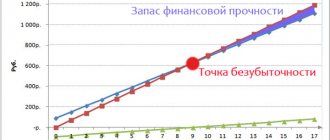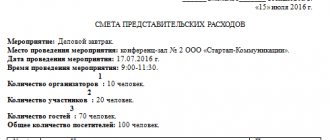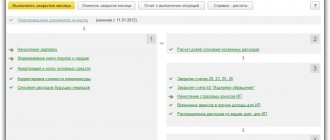Kinds
There are several methods to study the activities of an enterprise. First, the proportions of reporting items in the final indicator are calculated. Horizontal analysis (time) reflects changes in indicators compared to the previous period. Trend comparisons of data with previous periods are carried out in order to form a plan. The coefficients show the relationship between individual balance sheet items, and the reasons for their changes are reflected by factor analysis.
The enterprise most often conducts structural dynamic studies and calculates indicators (liquidity, financial stability, profitability, turnover and market activity). The following factors are taken into account:
- the value of the coefficients is influenced by the accounting policy of the organization;
- diversification of activities greatly complicates the analysis of indicators by industry;
- normative and optimal coefficients are different concepts.
Analysis of balance sheet items shows:
- volume of assets, their ratio, sources of financing;
- which items are changing at a rapid pace, and how this affects the structure of the balance sheet;
- share of reserves and remote control;
- the amount of equity, the degree of dependence of the company on borrowed resources;
- distribution of loans by repayment period;
- level of debt to the budget, banks and employees.
Advantages and disadvantages
Advantages
The main advantages of horizontal analysis of financial statements are:
- The ability to compare companies that differ significantly in size and scope of activity (based on relative deviations).
- The ability to establish trends in changes in the analyzed indicators.
It should be noted that maximum efficiency is achieved when the entire set of financial statements is analyzed simultaneously!
Flaws
When conducting this type of analysis of financial statements, it is necessary to pay special attention to the following points.
- The aggregation of information in financial statements may change over time due to ongoing changes in the chart of accounts and financial reporting standards. This will lead to the fact that direct comparison of data for different accounting periods will be incorrect, and the results of the analysis will be distorted.
- The results of horizontal analysis are sensitive to the choice of base period. For example, operating profit may show excellent growth dynamics compared to the previous quarter, but at the same time be at a low level compared to the same quarter a year earlier. To minimize the influence of this factor, it is necessary to analyze the dynamics of the indicator over several accounting periods.
- Sensitivity to the choice of base period can be used to manipulate the results of the analysis. The analyst may choose a base period in such a way as to embellish or underestimate the financial condition of the company. However, a consistent algorithm for choosing a base period can eliminate the negative impact of this factor.
- ← Vertical analysis of financial statements
- Index analysis of financial statements →
Vertical and horizontal balance analysis
The financial statements show the structure of the property and the sources of its financing. Vertical analysis shows the specific weight of individual balance sheet items. Based on the relative scores, performance comparisons are then made. The calculation algorithm is simple: the share of current non-current assets in the total balance sheet is determined, and then the reasons for their changes are analyzed.
Horizontal analysis consists of constructing tables that display the value of liabilities (assets) at the beginning and end of the year in absolute and relative values and their changes. If the calculation period is more than a year, the basic growth rates are determined.
These two types of research complement each other. In a vertical analysis, elements with a large specific gravity are highlighted, in a horizontal analysis, the emphasis is on abrupt changes.
Analysis Options
The documentation contains up-to-date information about the organization’s assets and its financial position at the time of reporting, as well as data for the previous reporting period necessary for correct comparison and analysis. To use such documents as arguments for making a decision, you must first conduct an analysis using a special technique. There are horizontal and vertical analysis of the balance sheet, which can be carried out when working with reporting documents.
Asset dynamics
The balance sheet reflects the property and the sources of its formation. If the currency (total) increases over the year, it is necessary to identify the reasons for the change. An increase in overdue accounts receivable indicates an ill-conceived sales policy that can lead to losses. By providing a commercial loan, the company makes advances to its customers and shares part of the income. But if payments from counterparties are delayed, it is forced to take out loans to ensure ongoing business activities. If fixed assets are updated, this means that the enterprise is functioning effectively. An increase in the amount of cash indicates an increase in liquidity. Ideally, there should be enough money to pay off 50% of short-term obligations. The surplus is worth investing.
Horizontal cash analysis
The main function of horizontal analysis is to compare parameters for the current period, as well as the previous period. As a result, it is possible to determine the dynamics, based on which conclusions can be drawn.
Horizontal analysis is a comparative analysis of financial indicators for periods of interest. When calculating, you need to take the values by line, and also track its changes over several periods.
These periods can be completely different intervals. However, typically the analysis is carried out by quarter or year. The number of periods that are analyzed may vary. It all depends on the tasks assigned. If a qualitative analysis is carried out, 3 periods are taken into account when calculating. As a rule, this technique is carried out to analyze the balance sheet, profit and loss statement, and changes in capital. Horizontal analysis can be carried out according to two approaches:
- Change in absolute values (for example, in rubles).
- Change in relative values (for example, percentage).
Reserves
The horizontal method of analysis allows you to compare the value of indicators with previous periods. When studying the composition of inventories, you should pay attention to changes in the volume of raw materials, work in progress, goods for resale. An increase in the share of reserves may indicate:
- increasing production potential;
- the desire to protect funds from impairment by investing in inventories;
- ineffectiveness of the strategy, as a result of which most of the OA is immobilized in inventories with low liquidity.
Vertical analysis
During this analysis, the correlation of some indicators with others is checked, in addition, individual elements in the enlarged group are also considered. For example, when conducting a vertical analysis of the balance sheet, you can consider what share of current assets will be inventories, debts or accounts payable. You can find out how much debt exceeds liabilities - this is usually part of the liquidity study process and directly affects further decisions regarding the development of the organization.
Liability changes
The ratio of equity and debt capital is also of considerable importance. The greater the share of personal funds, the higher the financial stability of the enterprise, it is less dependent on creditors, and it is not in danger of bankruptcy. A significant share of borrowed capital indicates a threat. Credits and loans will have to be repaid sooner or later. If the company does not have enough funds, it may go bankrupt. The absence of borrowed funds generally indicates high financial stability. But it is important to remember that if profitability exceeds the cost of attracting resources, the overall efficiency of using funds increases. Retained earnings can also be a source of financing for an organization.
Methodology and formula
As already mentioned, vertical analysis is aimed at presenting data not in absolute values, but in percentage units of the base value. This transformation of financial statements makes it much easier to compare financial data about a company over different periods of time, and also helps to compare it with similar information about other companies. The use of vertical analysis helps to identify trends that are not always visible when analyzing financial statements in the usual presentation.
The methodology is determined by the presentation of financial reporting information in the form of a relative value, which is expressed as a percentage.
When calculating, you must use a special formula:
Too lazy to read?
Ask a question to the experts and get an answer within 15 minutes!
Ask a Question
Figure 1. Formula. Author24 - online exchange of student work
According to this formula, the percentage of the base indicator is defined as the ratio of each independent position or line to a certain base value.
In a vertical analysis of the balance sheet, the total amount in the “Assets” section and the amount in the “capital and liabilities” section are used as the established value. Thus, absolutely all individual positions in the “Assets” section are a percentage of its total amount. Similar calculations also occur in the “Capital and Liabilities” section.
If we carry out a vertical analysis in relation to profit and loss, then the basic value, as a rule, will be revenue from product sales. The remaining items in this report are expressed as a percentage of it.
Example
Let's conduct a horizontal analysis of the enterprise's balance sheet. To do this, we will calculate the absolute and relative deviations of each reporting item. The horizontal analysis table will help us with this.
| Balance (thousand rubles) | 2013 | 2014 | Absolute | Rel. | ||
| Working capital | ||||||
| Cash | 17 | 12 | -6 | -33 % | ||
| Central Bank | 54 | 14 | -40 | -74 % | ||
| DZ | 271 | 389 | 118 | 44 % | ||
| Bills received | 47 | 43 | -5 | -10 % | ||
| Inventory | 51 | 45 | -6 | -12 % | ||
| Advances | 11 | 10 | -1 | -9 % | ||
| TOTAL OA | 452 | 513 | 61 | 13 % | ||
| OS | ||||||
| Buildings, structures | 350 | 358 | 8 | 2 % | ||
| Depreciation | 84 | 112 | 28 | 34 % | ||
| Residual value | 267 | 246 | -20 | -8 % | ||
| Investments | 15 | 15 | 0 | 0 % | ||
| GP | 28 | 28 | 0 | 0 % | ||
| Goodwill | 11 | 6 | -5 | -45 % | ||
| TOTAL OS | 321 | 295 | -25 | -8 % | ||
| ASSETS | 773 | 808 | 35 | 5 % | ||
| Short-term debt | ||||||
| short circuit | 143 | 97 | -46 | 32 % | ||
| Bills issued | 38 | 33 | -5 | 13 % | ||
| Accrued liabilities | 55 | 86 | 31 | 56 % | ||
| Loan | 7 | 11 | 4 | 62 % | ||
| Current portion of long-term debt | 5 | 5 | 0 | 0 % | ||
| Debts to the budget | 34 | 35 | 1 | 3 % | ||
| Short-term debt, total | 281 | 267 | -15 | -5 % | ||
| Long-term debt | ||||||
| Bonds payable | 80 | 80 | 0 | 0 % | ||
| Long-term loans | 15 | 10 | -5 | -33 % | ||
| Delayed NPP | 6 | 4 | -1 | -21 % | ||
| Long term debt, total | 101 | 94 | -6 | -6 % | ||
| Equity | ||||||
| Preference shares | 30 | 30 | 0 | 0 % | ||
| Ordinary shares | 288 | 288 | 0 | 0 % | ||
| Additional capital | 12 | 12 | 0 | 0 % | ||
| retained earnings | 61 | 117 | 56 | 93 % | ||
| TOTAL SK | 391 | 447 | 56 | 14 % | ||
| TOTAL Liabilities | 773 | 808 | 35 | 5 % | ||
A horizontal analysis of the balance sheet asset showed that fixed assets were not updated during the reporting period. The total amount of assets increased by 35 thousand rubles, and liabilities decreased. The changes occurred due to the growth of retained earnings. The amount of working capital increased by 60 thousand rubles. through accounts receivable. Part of the funds was used to pay off short-term debt (5.23%). The company compensated for this reduction by increasing liabilities, which in this example were one of the sources of financing. Horizontal financial analysis shows that the ratio of SC to SG is approximately 55:45. A positive trend is a decrease in the share of loans by 5% and long-term loans by 6%. There were no changes in the structure of equity capital during the reporting period. Other indicators should be analyzed for additional information.
Table 1 Horizontal and vertical analysis of the balance sheet asset
| ASSETS | Line code | At the beginning of the reporting year | At the end of the reporting period | Absolute deviation | Relative deviation | As a percentage of the balance sheet currency at the beginning of the year | As a percentage of the balance sheet currency at the end of the year |
| 1 | 2 | 3 | 4 | 5 | 6 | 7 | 8 |
| I. NON-CURRENT ASSETS | |||||||
| Intangible assets | 110 | — | — | ||||
| Fixed assets | 120 | 1683904 | 1691391 | 7 487 | 0,44 | 62,08 | 60,34 |
| Construction in progress | 130 | 70218 | 195485 | 125267 | 178,40 | 2,59 | 6,97 |
| Profitable investments in material assets | 135 | — | — | ||||
| Long-term financial investments | 140 | — | — | ||||
| Deferred financial assets | 145 | — | — | ||||
| Other noncurrent assets | 150 | — | — | ||||
| TOTAL for section I | 190 | 1754122 | 1886876 | 132754 | 7,57 | 64,66 | 67,31 |
| II. CURRENT ASSETS | |||||||
| Reserves | 210 | 262749 | 347228 | 84479 | 32,15 | 9,69 | 12,39 |
| including: | |||||||
| raw materials, supplies and other similar assets | 211 | 248524 | 334029 | 85505 | 34,41 | 9,16 | 11,92 |
| animals for growing and fattening | 212 | — | — | ||||
| costs in work in progress | 213 | — | — | ||||
| finished products and goods for resale | 214 | 77 | — | -77 | |||
| goods shipped | 215 | — | — | ||||
| Future expenses | 216 | 14148 | 13199 | -949 | -6,71 | 0,52 | 0,47 |
| other inventories and costs | 217 | — | — | ||||
| Value added tax on purchased assets | 220 | 19426 | 7748 | -11678 | -60,12 | 0,72 | 0,28 |
| Accounts receivable (payments for which are expected more than 12 months after the reporting date) | 230 | — | — | ||||
| including buyers and customers | — | — | |||||
| Accounts receivable (payments for which are expected within 12 months after the reporting date) | 240 | 215631 | 139029 | -76602 | -35,52 | 7,95 | 4,96 |
| including buyers and customers | 63461 | 74396 | 10935 | 17,23 | 2,34 | 2,65 | |
| Short-term financial investments | 250 | 328000 | 383400 | 55400 | 16,89 | 12,09 | 13,68 |
| Cash | 260 | 132764 | 38921 | -93843 | -70,68 | 4,89 | 1,39 |
| Other current assets | 270 | — | — | ||||
| TOTAL for section II | 290 | 958570 | 916326 | -42244 | -4,41 | 35,34 | 32,69 |
| BALANCE | 300 | 2712692 | 2803202 | 90510 | 3,34 | 100,00 | 100,00 |
Profit and Loss Statement
For clarity, we decided to use the table again
| Profit report | 2013 | 2014 | Absolute | Rel. |
| Revenue | 1230000 | 1440000 | 210000 | 17 % |
| Cost price | 918,257 | 1106,818 | 188,6 | 21 % |
| Material costs | 525,875 | 654,116 | 128,2 | 24 % |
| Salary | 184,5 | 201,6 | 17,1 | 9 % |
| Production costs | 167,05 | 214,12 | 47,1 | 28 % |
| Depreciation of tangible assets | 35,832 | 31,982 | -3,9 | -11 % |
| Depreciation of intangible assets | 5 | 5 | 0,0 | 0 % |
| Gross profit | 311,744 | 333,182 | 21,4 | 7 % |
| Administrative costs | 55,35 | 86,4 | 31,1 | 56 % |
| Marketing costs | 129,15 | 122,4 | -6,8 | -5 % |
| Operating profit | 127,244 | 124,382 | -2,9 | -2 % |
| Result from the sale of assets | 1,25 | 6,15 | 4,9 | 392 % |
| Dividends | 500 | 1520 | 1020,0 | 204 % |
| Profit before payment % | 128,994 | 132,052 | 3,1 | 2 % |
| % on bonds | 11,2 | 11,2 | 0,0 | 0 % |
| % on long-term debt | 3,2 | 2,4 | -0,8 | -25 % |
| % on loan | 1,08 | 1,56 | 0,5 | 44 % |
| Profit before tax | 113,5 | 116,9 | 3,4 | 3 % |
| NPP | 34,1 | 35,1 | 1,0 | 3 % |
| Emergency | 79,4 | 81,8 | 2,4 | 3 % |
A horizontal analysis of the income statement shows that for the year, revenue increased by 17%, but gross income increased by only 7%. The undesirable change occurred due to higher rates of growth in the cost of materials (24%) and production costs (28%). Operating profit decreased by 2% due to a significant (56%) increase in administrative costs. Despite the increase in costs, net profit increased by almost 3% due to a decrease in interest payments and an increase in profit from non-core activities (sale of assets).
Vertical analysis of the income statement
A vertical analysis of an income statement involves dividing each statement item by revenue and sometimes by total assets (for example, in the case of financial institutions). If there are multiple sources of income, you should break down the income into several elements and display the resulting number as a percentage.
For example, Table 2 presents a vertical analysis of a hypothetical company's income statement over two different time periods. Revenue is divided into the company's four services, each shown as a percentage of total revenue. In this example, revenue from Service A grew more significantly than the company's other services (up 45 percent in period 2).
What are the possible causes and consequences of this change in business structure? Was it a strategic decision by the company to focus on selling Category A services because of their higher profitability? Apparently not, because the company's earnings before interest and tax (EBIT) fell from 49 percent of sales to 41 percent, so other possible explanations must be considered. In addition, we note that the main reason for the decrease in profitability is that production costs increased from 15 percent to 25 percent of total revenue. Does the provision of service A require more company resources? If an analyst wants to predict the future performance of a company, then he needs to understand the reasons for the current trend.
Additionally, Table 2 shows that corporate income taxes as a percentage of sales fell significantly (from 15 percent to 8 percent). At the same time, the share of earnings before tax (EBT) (usually a more appropriate comparison) fell from 36 percent to 23 percent. Is the company moving its operations to a jurisdiction with lower tax rates? If not, what explains this?
Table 2 – Vertical analysis of the income statement of a hypothetical company
| Indicators | Period 1, % of total revenue | Period 2, % of total revenue | Absolute deviation |
| Source of revenue: service A | 30 | 45 | 15 |
| Source of revenue: service B | 23 | 20 | -3 |
| Source of revenue: service B | 30 | 30 | 0 |
| Source of revenue: service G | 17 | 5 | -12 |
| Total revenue | 100 | 100 | 0 |
| Cost price | 15 | 25 | 10 |
| Administrative expenses | 22 | 20 | -2 |
| Sales costs | 10 | 10 | 0 |
| Earnings on sales (EBIT) | 49 | 41 | -8 |
| Percentage to be paid | 7 | 7 | 0 |
| Earnings before taxes (EBT) | 42 | 34 | -8 |
| Current income tax | 15 | 8 | -7 |
| Net profit | 27 | 26 | -1 |
What else to pay attention to
Horizontal analysis, an example of which was presented earlier, allows us to draw general conclusions about the financial condition of the organization. In order to correctly determine the reasons for changes in the structure of assets, it is necessary to further examine Form No. 5. An increase in an item such as “WIP” in intangible assets indicates the diversion of resources into unfinished construction projects. This has a negative impact on the current position of the organization. The presence of long-term financial investments indicates the intensification of investment activity. The liquidity, profitability and risk of issuing securities should be further assessed.
The presence of patents and licenses in the first section of the balance sheet indirectly reflects the financing of intellectual property. A detailed analysis of the use of intangible assets is important for management. It cannot be carried out based on balance sheet data alone. Other types of reporting should be additionally involved.
Ratio analysis of financial reporting indicators
Methods for analyzing financial statements, as mentioned above, in addition to horizontal and vertical analysis, include ratio analysis.
There are dozens of different ratios that can be used to analyze financial statements. In this article we will present several important indicators and group them into five main categories. The coefficients are presented in a simplified form to make them easier to understand.
1. Liquidity ratios 2. Profitability ratios 3. Solvency ratios 4. Operating efficiency indicators 5. Cash flow indicators
We invite you to a free webinar
Manager's dashboard is a tool for operational monitoring of key indicators
June 09 at 11:00 (Moskva g.)
1 hour
Sign up
Liquidity ratios
A company's liquidity is the ability to meet short-term financial obligations. Liquidity analysis is performed by comparing a company's most liquid assets, which can be easily converted into cash, with its short-term liabilities.
In general, the higher the level of coverage of short-term liabilities by liquid assets, the better. If a company has a low level of coverage, then this may be a sign that it will have difficulty meeting its short-term financial obligations and therefore conducting ongoing operations.
In times of business or economic crisis, a company with insufficient liquidity may be forced to take drastic measures to meet its obligations. These actions may include the liquidation of productive assets, the sale of inventory, or even the sale of a business unit, which in turn can harm both the short-term viability of the company and the long-term financial health.
The calculation of liquidity ratios is based on the company's current assets and current liabilities taken from the company's balance sheet form.
Examples of liquidity ratios:
- Current ratio;
- Quick liquidity ratio;
- Cash ratio.
Current ratio is the company's ability to cover its short-term obligations with current assets.
Current ratio = Current assets/Current liabilities
A current ratio of 1.0 or higher indicates that the company is well positioned to meet its current or short-term obligations. A ratio of less than 1.0 may be a sign of problems or financial difficulties.
The quick ratio is an extension and refinement of the current ratio, which measures the level of the most liquid current assets that are available to cover current liabilities. The quick ratio is more conservative than the current ratio because it excludes inventories and other current assets, which are generally more difficult to convert into cash.
(Cash equivalents + marketable securities + accounts receivable)/Current liabilities
The cash ratio is another measurement of a company's ability to meet its short-term obligations.
(Cash + marketable securities)/Current liabilities
Profitability ratios
This group includes various profitability indicators. These ratios, as well as operating performance indicators, give users a detailed understanding of how well a company is using its resources to generate profits and increase shareholder value.
The long-term profitability of a company is very important, both for the survivability of the company and for shareholders. It is these coefficients that can give an understanding of all components of profit. This group includes the four most important profit indicators, which are reflected in different sections of the income statement.
There are four levels of profit on an income statement: gross profit, operating profit, profit before taxes and net profit. The term "margin" can refer to an absolute number for a given profit level and/or a number as a percentage of net sales/revenue. Profitability analysis uses a percentage calculation to provide a comprehensive assessment of a company's profitability over a 3-5 year period compared to both its peers and industry benchmarks.
The purpose of margin analysis is to identify positive/negative trends in a company's profits. It's largely the quality and growth of a company's earnings that drive its share price.
Gross Margin = Gross Profit/Net Sales (Revenue)
Operating Margin = Operating Profit/Net Sales (Revenue)
Pre-tax profit margin = Pre-tax profit/Net sales (revenue)
Net Margin = Net Profit/Net Sales (Revenue)
Debt ratios
A company's debt ratio is the ratio of total debt to total assets. Total debt includes both short-term and long-term debt. There are several debt ratios that give users an idea of a company's overall debt load as well as its equity to debt ratio.
Debt ratios can be used to determine the overall level of financial risk faced by a company and its shareholders. In general, the larger the amount of debt, the higher the potential level of financial risks the business may face, including bankruptcy.
Debt is a form of financial leverage. The greater the company's leverage, the higher the level of financial risk. On the other hand, a certain increase in leverage can contribute to the growth of the company. Well-managed companies seek the optimal amount of financial leverage for their specific situation.
Examples of odds:
- Debt ratio;
- Debt to equity ratio.
The debt ratio compares a company's total debt to its total assets. This gives creditors and investors an idea regarding the amount of leverage used by the company. The lower the percentage, the less leverage the company uses, and the stronger its position. In general, the higher the ratio, the greater the risk the company is taking on.
Debt Ratio = Total Liabilities/Total Assets
The debt-to-equity ratio is another ratio that compares a company's total debt to its total shareholders' equity. This is an estimate of the portion of a company's balance sheet that is financed by suppliers and creditors.
As with the previous ratio, lower ratios mean the company uses less leverage and has a more resilient position.
Operational efficiency indicators
Each of the ratios in this group has different inputs and measures different segments of a company's overall operating performance. These ratios give users an idea of the company's performance and management over the period being measured.
These ratios show how effectively a company uses its assets to generate revenue, how effectively a company converts sales into cash, and how it uses its resources to generate sales and increase shareholder value. In general, the higher these ratios, the better for shareholders.
Examples of operational efficiency ratios
- return on assets;
- Sales (income) ratio per employee;
- Operating cycle ratio.
Capital productivity is a ratio that is an indicator of the effectiveness of a company's fixed assets (fixed assets) in relation to generating sales. For most companies, investment in fixed assets represents the largest component of total assets. This ratio is intended to reflect the company's effectiveness in managing these significant assets. The higher the annual ratio, the better.
Return on assets = Revenue/Fixed Assets
Sales (income) ratio per employee . As an indicator of staff productivity, this ratio shows sales or revenue per employee. The higher the score, the better. On this dimension, labor-intensive businesses (e.g., retailers) will be less productive than high-tech, high-productivity manufacturers.
Sales per employee = Revenue/Number of employees (average)
Cash flow indicators
This group examines cash flow indicators that focus on the amount of cash generated and the financial strength framework a company has in place. These ratios can give users another look at a company's financial health and performance. This group of ratios uses cash flow in comparison to other company metrics.
Examples of cash ratios:
- Operating cash flow to sales ratio;
- Net cash flow to operating cash flow ratio;
- Cash flow coverage ratios.
Operating cash flow to sales ratio is the ratio, expressed as a percentage, of a company's operating cash flow to its net sales or earnings, which gives investors an idea of the company's ability to convert sales into cash.
Operating Cash Flow to Sales Ratio = Operating Cash Flow/Net Sales (Revenue)
The free cash flow to operating cash flow ratio measures the relationship between free cash flow and operating cash flow. Free cash flow is most often defined as operating cash flow minus capital expenditures, which is considered in analysis to be a significant outflow of funds to maintain a company's competitiveness and efficiency. The cash flow remaining after this deduction is considered “free” cash flow, which becomes available for use for expansion, business acquisition, and/or financial stability. The higher the percentage of free cash flow embedded in a company's operating cash flow, the greater the company's financial strength.
Free Cash Flow to Operating Cash Flow = (Operating Cash Flow - Capital Expenditures)/Operating Cash Flow.
Thus, the financial condition of the organization is determined based on the analysis of financial statements. Financial analysis based on reporting data uses the following methods of analyzing financial statements: horizontal, vertical and ratio. This analysis can be conveniently carried out in an automated system, for example, “WA: Financier”, which allows you to calculate any ratios using a special tool for custom reports, as well as conduct horizontal and vertical analysis of reporting.
Videos of past webinars on the topic “Management Accounting / IFRS”
Look









